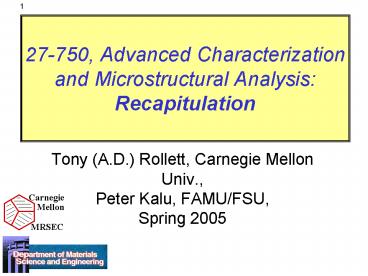27750, Advanced Characterization and Microstructural Analysis: Recapitulation - PowerPoint PPT Presentation
1 / 9
Title:
27750, Advanced Characterization and Microstructural Analysis: Recapitulation
Description:
1. 27-750, Advanced Characterization and Microstructural Analysis: Recapitulation ... Despite the crystalline nature of most useful and interesting materials, crystal ... – PowerPoint PPT presentation
Number of Views:85
Avg rating:3.0/5.0
Title: 27750, Advanced Characterization and Microstructural Analysis: Recapitulation
1
27-750, Advanced Characterization and
Microstructural Analysis Recapitulation
- Tony (A.D.) Rollett, Carnegie Mellon Univ.,
Peter Kalu, FAMU/FSU, Spring 2005
2
Microstructure-Properties Relationships
Processing
Performance
Design
Properties
Microstructure
3
Course Objective
- Many courses deal with microstructure-properties
relationships, so what is special about this
course?! - Despite the crystalline nature of most useful and
interesting materials, crystal alignment and the
associated anisotropy is ignored. Yet, most
properties are sensitive to anisotropy.
Therefore microstructure should include
orientation. - The objective of this course was to provide you
with the quantitative tools to understand and
quantify texture and to solve problems that
involve texture and anisotropy.
4
Connections
- Crystals are anisotropic.
- A collection of crystals (a polycrystal) is
therefore anisotropic unless all possible
orientations are present. - Almost any processing of a material changes and
biases the crystal orientations, leading to
texture development. - Anisotropy can be taken advantage of therefore
it makes sense to engineer (control, design) the
texture of a material.
5
Lecture List (abbreviated)
12. Graphical representation of ODs 13. Symmetry
(crystal, sample) 14. Euler angles, variants 15.
Volume fractions, Fiber textures 16. Grain
boundaries 17. Rodrigues vectors, quaternions 18.
CSL boundaries 19. GB properties 20. 5-parameter
descriptions of GBs 21. Herrings relations 22.
Elastic, plastic anisotropy 23.
Taylor/Bishop-Hill model 24. Yield Surfaces
- 1. Introduction
- 2. X-ray diffraction
- 3. Calculation of ODs from pole figure data,
popLA - 4. Texture components, Euler angles
- 5. Orientation distributions
- 6. Microscopy, SEM, electron diffraction
- 7. Texture in bulk materials
- 8. EBSD/OIM
- 9. Misorientation at boundaries
- 10. Continuous functions for ODs
- 11. Stereology
6
What did we learn?
- 1. How to measure texture
- Method 1 x-ray pole figures
- Method 2 electron back scatter diffraction
(EBSD) - Method 3 transmission electron microscopy (TEM)
- Stereology sections through 3D materials
- 2. What causes texture to develop in materials,
and how does it depend on material type and the
processing history? - Deformation of bulk metals rolling vs. torsion
etc. - Annealing grain growth, recrystallization
- Thin films
7
What did we learn? (contd.)
- 3. How to describe texture quantitatively, how to
plot textures, and how to understand texture - Method 1 pole figures
- Method 2 orientation distributions (OD)
- Symmetry crystal symmetry, sample symmetry
- Components
- Fibers
- How to obtain ODs from pole figures
- 4. How does anisotropy depend on texture?
- Elastic anisotropy
- Plastic anisotropy yield surfaces
- Corrosion (grain boundaries)
8
What did we learn? (contd.)
- 5. Grain Boundaries
- Grain boundary atomic structure low angle vs.
high angle boundaries - Special grain boundaries Coincident Site Lattice
boundaries (CSL) - How to describe grain boundary crystallography
axis-angle, Rodrigues vectors - How to measure grain boundaries
- 6. Underlying Concepts
- Different descriptions of rotations Miller
indices, Euler angles, matrices, axis-angle
pairs, Rodrigues vectors, quaternions - How to work with distributions
- Spherical harmonics (series expansions)
- Discretization of distributions
- Volume fractions
9
Summary
- Microstructure contains far more than qualitative
descriptions (images) of cross-sections of
materials. - Most properties are anisotropic which means that
it is critically important for quantitative
characterization to include orientation
information (texture). - Many properties can be modeled with simple
relationships, although numerical implementations
are (almost) always necessary.































